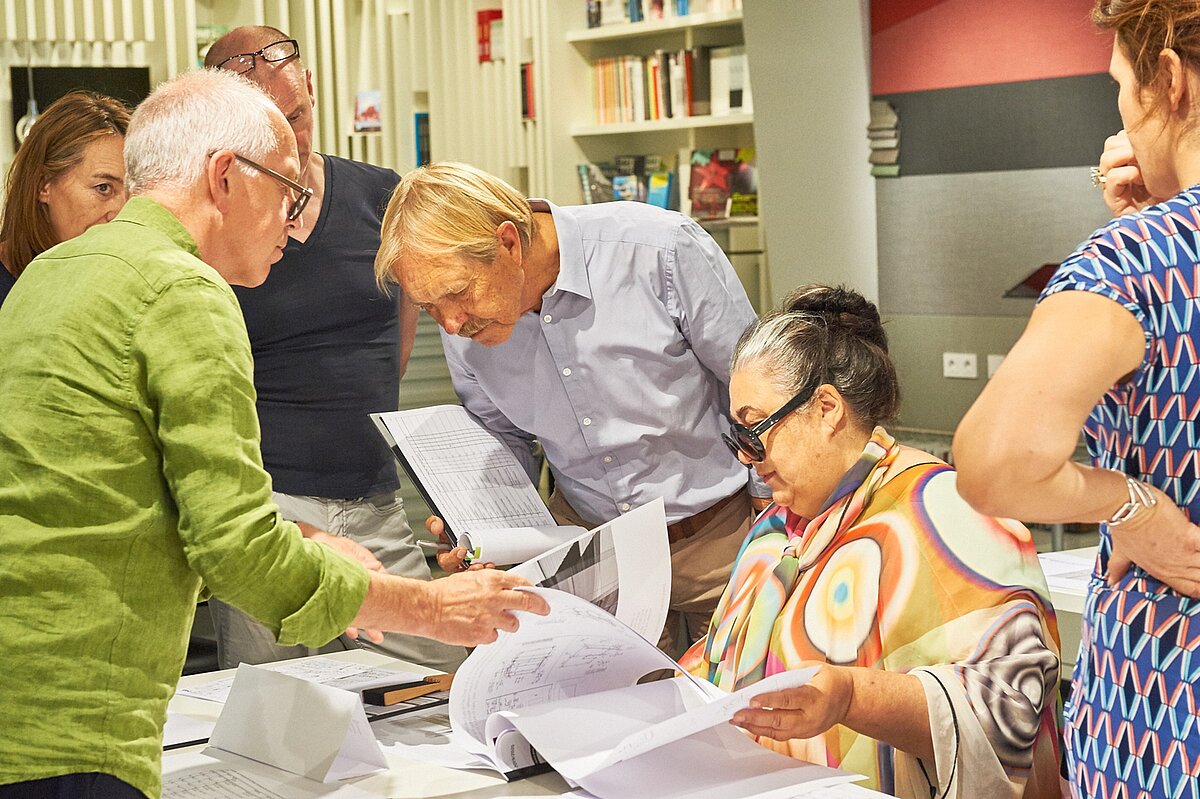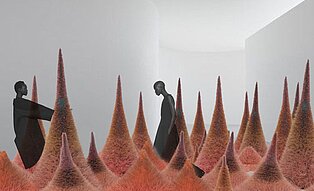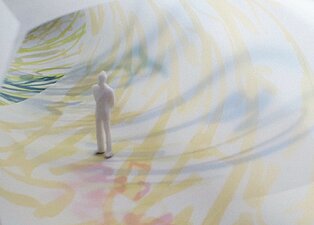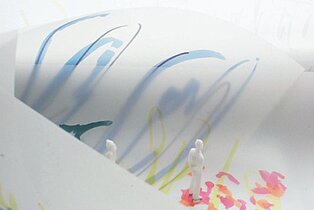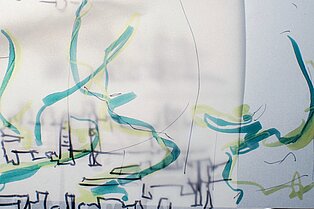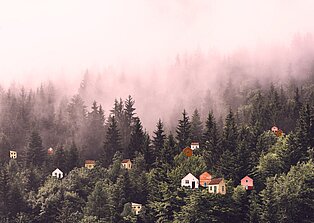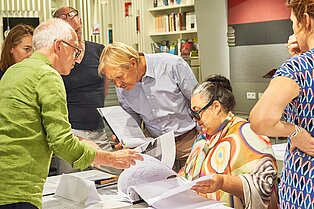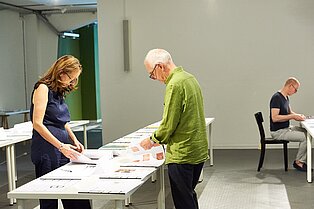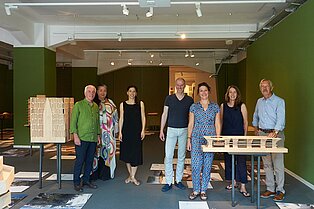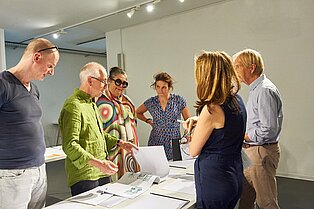The Interior Scholarship – the AIT-Scholarship of the Sto Foundation has been awarded!
The Interior Scholarship, the AIT Scholarship of the Sto Foundation, is awarded four times this year. During the jury session on 26 July 2019, one student each from the Hochschule für Gestaltung und Kunst, Basel, Switzerland the Estonian Academy of Arts, Tallinn, Estonia and two students from the Burg Giebichenstein Kunsthochschule, Halle, Germany impressed the jurors. With a monthly subsidy of 500 Euros each to help cover the costs of living, the students are given the opportunity to fully dedicate themselves to their studies for a whole year.
The Interior Scholarship, the AIT Scholarship of the Sto Foundation, which is endowed with 24,000 Euros, was awarded for the ninth time in 2019. As in previous years, submissions arrived from all over Europe, this time involving 70 applicants from 14 countries. This year’s winners are Lara Grandchamp (Hochschule für Gestaltung und Kunst, Basel, Switzerland), Karolin Kull (Estonian Academy of Arts, Tallinn, Estonia), Alfiia Koneeva and Janna Theda Radlow (both Burg Giebichenstein Kunsthochschule, Halle, Germany). During the jury session on 26 July 2019 at the AITArchitekturSalon, the jurors Giorgio Gullotta (GIORGIO GULLOTTA ARCHITEKTEN, Hamburg,Page 2 of 8 Germany), Sabine Krumrey (brandherm + krumrey interior architecture, Hamburg, Germay), Tamara Pallasch (pallasch interiordesign, Berlin, Germany), Ushi Tamborriello (ushitamborriello Innenarchitektur Szenenbild, Rieden b. Baden, Switzerland), Peter Cheret (Representative of Sto Foundation Cheret Bozic Architekten BDA DWB and University Stuttgart, Stuttgart, Germany) and Uwe Koos (chairman of the foundation council) assessed and discussed both the quality of the submitted student projects as well as the creative designs of this year’s impromptu assignment, which was an assessment criterion for the sixth time.
This year the students had been asked to create a space themed WEAVING which should have discussed the following questions: How does nature take over space? How does space take over nature? Define spaces in-between, which can evolve when considering the coexistence of nature and space: Which areas can be newly generated when nature creates a space that has never existed before? What is the atmospheric significance this space then assumes, and what are the challenges? When exactly does this space become space and when is it a non-space? Can this interwoven space be a secure place of personal freedom and sovereignty? The personal idea was to be illustrated in the form of individually selected, concept-supporting presentation techniques, such as visualizations, model photos, collages, drawings, sketches, etc.
After an assessment procedure with three rounds and extensive discussion, the jury unanimously determined the winners, who primarily stood out due to their individual attitudes and creative thinking. The available prize money of 24,000 Euros was divided between the four students from Estonia, Germany and Switzerland who can now happily look forward to a monthly allowance of 500 Euros each.
The scholarships are funded by the Sto Foundation, which regards “the education of the young generation […] as an investment in the future of our society” and wants to afford the winners a carefree study period of one year. For this reason, Sto Foundation supports young people in their academic education. As an overriding purpose, the Sto Foundation takes up the guiding theme of “Aware Constructing” of Sto SE & Co. KGaA and aims at global technology leadership in the industry to achieve a people-friendly and sustainable design of built living environments.
“When appraising the many good pieces of work, a consistency in the persons approach to the various subjects played a crucial role. Fundamental criteria in our judging were whether the candidates noticeably strove to achieve their own styles and evidenced a clear, independent approach. With 70 entries from 25 countries we faced an astonishing variety and diversity of submissions, which reflected the applicants’ different cultural backgrounds. The impromptu task created a kind of laboratory situation and played a special role in this regard, as the uniqueness of the impromptu task turned out to be an exemplary evaluation method that complemented the candidates’ portfolios. Thanks to the high quality of this year’s entries, it was once again possible to award four scholarships, something extremely gratifying for everybody involved.” Statement by the jury on 26 July 2019 in Hamburg, Germany
The scholars of the Interior Scholarship 2019/2020
Lara Grandchamp
Hochschule für Gestaltung und Kunst, Basel, Switzerland
The jury’s verdict
Laura Grandchamp demonstrated a high degree of independence in how she handled the substance of the space-related topic. The works she submitted stand out for their consistent, subtle appearance and her graphic work was appealingly careful. She has tackled the space-related topics on which the pieces were based from a great variety of angles and adequately visualized the subject matter. Her chosen portrayal techniques range from drawings to graphic media and collage and achieve a poetic depth with an evocative effect.
Alfiia Koneeva
Burg Giebichenstein Kunsthochschule, Halle, Germany
The jury’s verdict
What is particularly impressive was Koneeva’s design response to the impromptu task: She created something not only unique and surprising but also playful and, at the same time, precise. By using materials and a stylistic idiom that are quite unexpected, she produces spaces that are compellingly coherent. The nature of her particular and utterly quirky approaches is also apparent from the other works in her portfolio.
Karolin Kull
Estonian Academy of Arts, Tallinn, Estonia
The jury’s verdict
The analytical approach on which Karolin Kulls based her work ensure her creative proposals seem abstract and concrete in equal measure. She always relates the scale of her works to human proportions. Her consistently clear style is reflected in very different forms of presentation. Something really worthy of mention is the poetic minimalism that is characteristic of her designs.
Janna Theda Radlow
Burg Giebichenstein Kunsthochschule, Halle, Germany
The jury’s verdict
The fascinating furniture design in Janna Theda Radlow’s portfolio is as persuasive as the consistently good, attractive presentation of her designs. The solution she dreamed up in response to the impromptu task is not only poetically humorous but also good and visionary. In her designs she references the preoccupations of the age we live in, such as the need for places to which we can withdraw that are both personal and of a high quality.
Jury 2019/2020
Giorgio Gullotta
GIORGIO GULLOTTA ARCHITEKTEN, Hamburg, Germany
Giorgio Gullotta founded Giorgio Gullotta Architects in 2006 after working with Gerkan Marg und Partner and an office partnership with H. Akyol and P. Kamps. In collaboration with an international team of architects, interior designers, and engineers, he implements national and international projects of any scale. All projects, regardless of their size, from the design to the handover of a building to the client, are devised and executed under the aspects of "holistically conceived implementation processes" and "high-quality architecture".
Sabine Krumrey
brandherm + krumrey interior architecture, Hamburg, Germany
Sabine Krumrey studied Interior Architecture at FH Rosenheim. After her graduation, different positions in interior design offices in the South of Germany followed, until she set up her own business in 1993. In 1996, Susanne Brandherm joined her. The common office brandherm krumrey interior architecture, located in Hamburg and Cologne, was founded in 1999. Working priorities of the multi-award winning office involve healthcare, shop and fair designs, hotel furnishing, office- and private furnishing. In addition to her active lecturing and jury duty Sabine Krumrey also works as a lecturer in the faculty of “Space concepts and Design” at the AMD Academy of Fashion and Design in Hamburg since March, 2015.
Tamara Pallasch
pallasch interiordesign, Berlin, Germany
Tamara Pallasch and her Berlin-based office Pallasch Interiordesign focus on individual interior design for hotels and restaurants as well as the creation high-quality private interiors. The basis for the design of a hotel is the location. Exploring it and finding out what makes it special, which contexts but also which new paths have to be taken in order to create a contemporary hotel is the big challenge. The office has won numerous international awards for its hotel concepts.
Ushi Tamborriello
ushitamborriello Innenarchitektur Szenenbild, Rieden b. Baden, Switzerland
Ushi Tamborriello is an interior designer and scenographer who creates internationally acclaimed spatial productions with her office in Switzerland. One of the main focuses of her work is the design of aesthetically independent spaces in which condensed atmospheres enable new sensual experiences. In recent years, she has gained special recognition as a designer of innovative bathrooms and wellness facilities.
Peter Cheret
Representative of Sto Foundation and Cheret Bozic Architekten BDA DWB, Stuttgart, Germany
Following his architectural studies at Konstanz University of Applied Sciences and Stuttgart University, Peter Cheret initially worked as a freelance architect before founding the office Cheret und Englert in 1988. In 1993, he established the office Cheret Bozic Architekten. After teaching activities in ‘Introduction to Design’ at Stuttgart University and his visiting professorship at Trier University of Applied Sciences, he was offered a professorship at Stuttgart University at the Faculty of Building Construction and Design in 1995. Additionally, he is a member of the board of trustees of the Sto Foundation.
Uwe Koos
Chairman of the board of Sto-Foundation, Stühlingen, Germany
After his apprenticeship as a master painter and varnisher, he studied to become a colour designer. A study visit brought Uwe Koos to the University of Minnesota, USA. After working as a freelancer in the field of colour and design, Uwe Koos established the colour design department for the Sto Company with studios in Germany, Europe, North America and Asia. For more than 30 years, he was responsible for the positioning of strategic design and international marketing communication at Sto AG. Since the establishment of Sto Foundation in 2005, Uwe Koos has been Chairman of the Foundation Council.
Kristina Bacht
Curator AIT-ArchitekturSalons, Publishing Director GKT, Hamburg, Germany
Kristina Bacht studied architecture and urban planning at Technische Universiteit Delft/Netherlands and Universidad Tecnica Federico Santa Maria in Valparaiso/Chile. During and after her studies, she worked with various international architecture offices in Germany, the USA and the Netherlands. Since 2005, Kristina Bacht has been employed with AIT-Dialog with a work focus on architecture communication. In 2009, she developed and established the AIT ArchitekturSalons with venues in Hamburg, Cologne and Munich. As head curator of the galleries she organises exhibitions of internationally renowned architects and is responsible for numerous international architecture congresses and symposia, competitions, workshops, focus groups as well as editorial events, architecture magazines and publications. From 2009-2013, she acted as deputy publishing director, and became publishing director in 2013.
Contact
Ir. Kristina Bacht (MSc Arch)
Curator | Director AIT-ArchitekturSalons
Publishing Director
Gesellschaft für Knowhow-Transfer in Architektur und Bauwesen mbH
Bei den Mühren 70 | 20457 Hamburg
Fon: +49 (0)40 / 70 70 898-11
Fax: +49 (0)40 / 70 70 898-20
E-Mail: kbacht@ait-online.de
stipendium@ait-architektursalon.de
www.ait-architektursalon.de/stipendium


